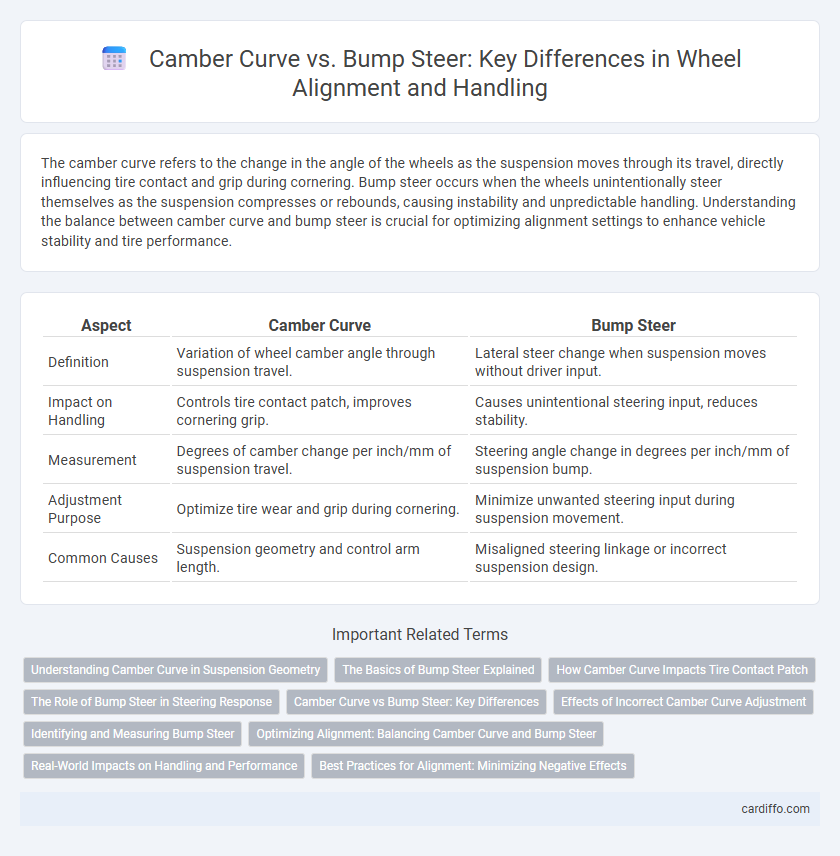The camber curve refers to the change in the angle of the wheels as the suspension moves through its travel, directly influencing tire contact and grip during cornering. Bump steer occurs when the wheels unintentionally steer themselves as the suspension compresses or rebounds, causing instability and unpredictable handling. Understanding the balance between camber curve and bump steer is crucial for optimizing alignment settings to enhance vehicle stability and tire performance.
Table of Comparison
| Aspect | Camber Curve | Bump Steer |
|---|---|---|
| Definition | Variation of wheel camber angle through suspension travel. | Lateral steer change when suspension moves without driver input. |
| Impact on Handling | Controls tire contact patch, improves cornering grip. | Causes unintentional steering input, reduces stability. |
| Measurement | Degrees of camber change per inch/mm of suspension travel. | Steering angle change in degrees per inch/mm of suspension bump. |
| Adjustment Purpose | Optimize tire wear and grip during cornering. | Minimize unwanted steering input during suspension movement. |
| Common Causes | Suspension geometry and control arm length. | Misaligned steering linkage or incorrect suspension design. |
Understanding Camber Curve in Suspension Geometry
Camber curve in suspension geometry describes how the wheel's camber angle changes through the suspension's travel, directly influencing tire contact patch and vehicle handling. Unlike bump steer, which refers to unintended steering input caused by suspension movement, camber curve is a deliberate tuning aspect to optimize grip and stability during cornering. Engineers analyze camber curve characteristics to balance tire wear, traction, and driver feedback for improved performance and safety.
The Basics of Bump Steer Explained
Bump steer occurs when the wheels change their steering angle as the suspension moves up and down, causing unintended directional changes. The camber curve describes how the wheel's tilt angle changes through suspension travel, influencing tire contact and handling but not directly causing bump steer. Proper alignment minimizes bump steer by ensuring suspension geometry maintains consistent wheel angles relative to road surface during compression and rebound.
How Camber Curve Impacts Tire Contact Patch
Camber curve significantly impacts tire contact patch by altering the vertical alignment angle as suspension moves through its travel, which directly affects tire grip and wear patterns. A well-optimized camber curve maintains maximum tire contact with the road surface during cornering, enhancing traction and vehicle stability. In contrast, improper camber curve can lead to uneven tire load distribution, increasing bump steer sensitivity and reducing overall handling performance.
The Role of Bump Steer in Steering Response
Bump steer significantly impacts steering response by causing the wheels to involuntarily change direction as the suspension compresses or rebounds, potentially leading to unpredictable handling and reduced driver control. Unlike camber curve, which primarily affects tire contact patch and grip during suspension movement, bump steer directly influences the vehicle's directional stability and feedback by altering toe angles dynamically. Proper suspension tuning aims to minimize bump steer to ensure consistent and precise steering behavior throughout the suspension travel.
Camber Curve vs Bump Steer: Key Differences
Camber curve refers to the variation of the wheel's camber angle throughout suspension travel, which directly influences tire contact patch and cornering grip. Bump steer describes the unintended change in steering angle caused by vertical suspension movements, affecting vehicle stability and steering precision. Understanding the key differences between camber curve and bump steer is essential for optimal suspension tuning and maintaining consistent handling dynamics.
Effects of Incorrect Camber Curve Adjustment
Incorrect camber curve adjustment can lead to uneven tire wear, reduced traction, and compromised handling performance. This misalignment exacerbates bump steer by altering the suspension geometry, causing the wheels to steer unintentionally during suspension travel. Proper camber curve tuning ensures consistent tire contact with the road, minimizing bump steer and enhancing vehicle stability and safety.
Identifying and Measuring Bump Steer
Bump steer occurs when the wheel's steering angle changes as the suspension moves through its travel, causing unintended deviations in alignment during compression or rebound. Measuring bump steer involves using a bump steer gauge or a steer plate to track changes in the toe angle relative to suspension displacement, often recorded through a full range of vertical wheel travel. Accurate identification requires isolating suspension movement without turning inputs, ensuring precise detection of toe variations that affect handling and tire wear.
Optimizing Alignment: Balancing Camber Curve and Bump Steer
Optimizing alignment requires a precise balance between camber curve and bump steer to maintain tire contact and vehicle stability during suspension travel. Excessive camber curve can lead to uneven tire wear while improper bump steer tuning disrupts steering response and safety. Fine-tuning suspension geometry minimizes camber variation and controls bump steer, enhancing overall handling and tire longevity.
Real-World Impacts on Handling and Performance
Camber curve directly affects tire contact patch during suspension travel, influencing cornering grip and overall handling precision. Bump steer causes unintended toe changes as the suspension moves, leading to instability and unpredictable vehicle response, especially over uneven road surfaces. Understanding and optimizing both factors is crucial for maintaining consistent steering feel and maximizing performance in real-world driving conditions.
Best Practices for Alignment: Minimizing Negative Effects
Camber curve influences tire contact patch during suspension travel, directly affecting handling and tire wear, while bump steer occurs when toe changes through suspension movement cause unpredictable steering input. Best practices for alignment emphasize minimizing camber curve by optimizing static camber angles and suspension geometry to maintain consistent tire contact, and reducing bump steer through precise rigging of tie rods and steering links. Proper calibration ensures improved vehicle stability, reduced tire degradation, and enhanced driver control.
Camber Curve vs Bump Steer Infographic

 cardiffo.com
cardiffo.com